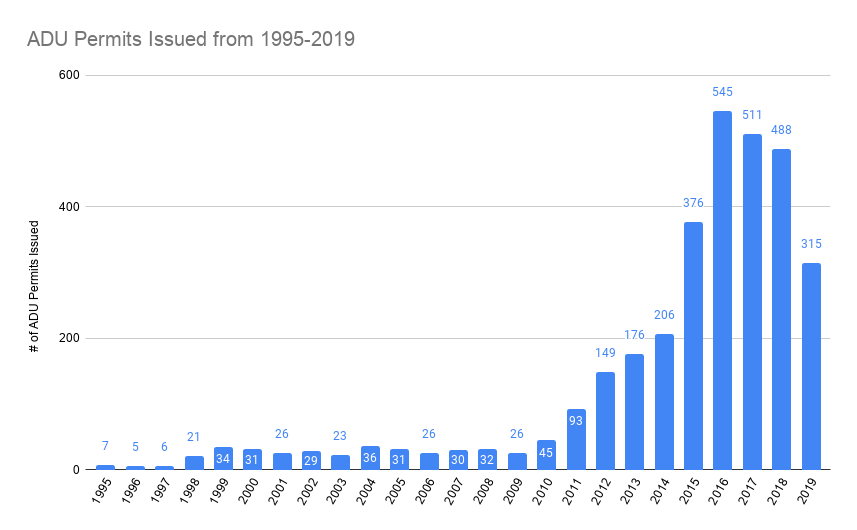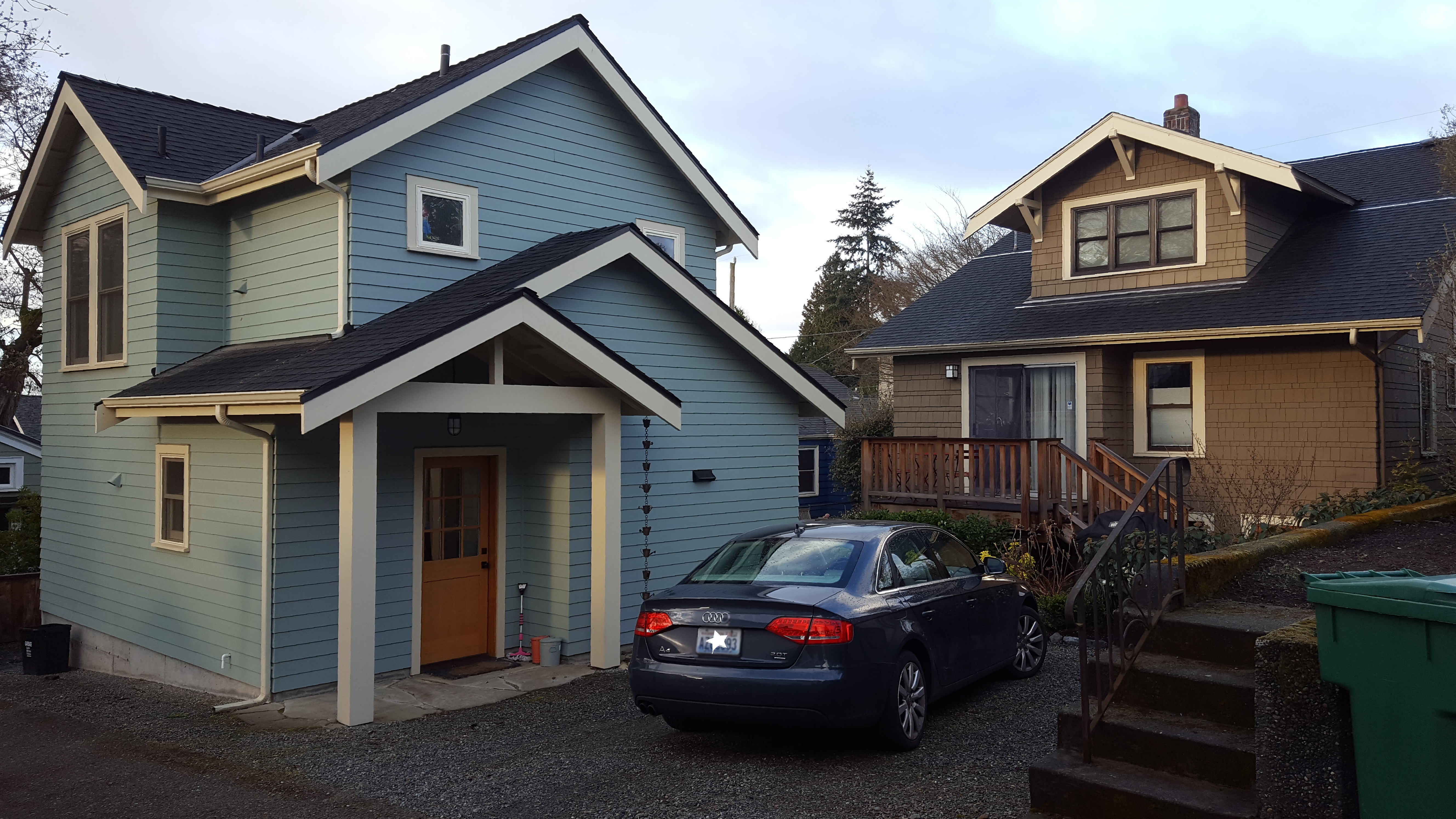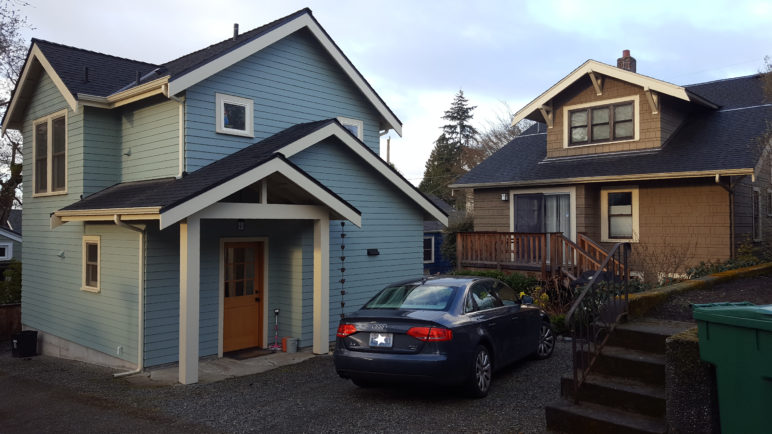In recent years, cities and states across North America have turned their attention to reforming exclusionary zoning rules to address housing shortages and create walkable neighborhoods with access to good jobs and public transit. Under exclusionary zoning, most cities reserve a majority of residential land for expensive, single-detached houses that are out of reach for most families. With the removal of these rules, neighborhoods can open up and offer more diverse, affordable housing types.
A first step for many cities and states, particularly on the West Coast, has been to liberalize rules for accessory dwelling units (ADUs) to spur their production. From states as large as California to small suburbs like Tigard, Oregon, removing barriers such as parking requirements and anti-renter owner occupancy rules unlocked demand for backyard cottages and mother-in-law suites.
From states as large as California to small suburbs like Tigard, Oregon, removing barriers such as parking requirements and anti-renter owner occupancy rules unlocked demand for backyard cottages and mother-in-law suites.

Permitting data show the reforms are working. In California, ADU permits jumped by 10,000 in a single year. Seattle has already accepted more ADU permit applications in October 2020 than in all of 2019, a result of 2019 rule changes. Permit applications also increased in some smaller and more suburban cities that passed reforms, including Tacoma, Washington and Tigard, Oregon.
These ADU surges come as no surprise to those familiar with policy in Vancouver, British Columbia. Vancouver began removing ADU barriers in the 1990s. Most importantly, the city abolished mandates for parking and for the ADU owner to live on site and legalized two ADUs per lot. Today in Vancouver, one in three detached houses has an ADU.
ADU permits jumped after reforms up and down the West Coast
California
California legislators have been on a mission to enact accessory dwelling reform since 2016, when they passed rules that sped up permitting time, removed parking requirements for ADU smaller than 500 square feet (JADUs) and for all ADUs near transit, and capped utility connection fees. Last year’s reform allowed two backyard cottages on all lots with single-detached houses or small-scale multifamily homes. This change effectively triplexed the most populous state in the nation. The 2019 rule changes also banned through 2025 requirements for the owner to live on site, capped parking requirements far from transit to one space per ADU, and waived impact fees for ADUs smaller than 750 square feet.
Since California’s latest round of reforms, ADU permits jumped from about 6,000 in 2018 to nearly 16,000 in 2019. The city of Los Angeles, where state rules replaced the city’s ADU code entirely, saw the largest spike, compared with other major cities. LA’s ADU permits doubled from 3,400 in 2018 to 6,800 in 2019, according to researchers from UC Berkeley’s Center for Community Innovation.
Washington
In the summer of 2019, Seattle city councilmembers passed the best local ADU policy of any large US city. After nearly five years of process and obstruction from anti-housing activists, the city adopted new rules to allow two ADUs per lot, as well as eliminate parking and owner occupancy mandates. According to city data compiled by the Master Builders Association of King and Snohomish counties, by October of this year, the city accepted 447 permit applications, surpassing the 317 permits in all of 2019.
Tacoma saw 148 permit applications after its 2019 reform legalizing backyard cottages and removing parking and owner occupancy requirements, among other things. The city reports an increase in permit applications from 0.5 per month before the code change to 9.25 per month afterwards.
Three other Washington cities have enacted ADU reforms in the past year, although city officials have yet to see a change in permitting numbers. It’s likely still to early to see the impact of these recent reforms.
Burien passed new rules in December 2019 that not only allowed two ADUs on a single-family lot, but removed owner occupancy requirements and eliminated parking requirements for ADUs within a quarter mile of a transit stop.
Similarly, Kirkland allowed two ADUs per lot and removed owner occupancy restrictions in March of this year. But it went a step further by removing parking requirements entirely for lots with a single ADU. Though the city still requires one additional off-street parking space for lots with two ADUs.
In September, Kenmore amended its ADU rules, most notably to drop the requirement for one parking space per ADU and to allow backyard cottages on lots smaller than 10,000 square feet, where the city previously banned detatched accessory dwelling units (DADUs).
Oregon
Tigard, a suburb just outside Portland, updated its rules in 2018 to legalize backyard cottages, allow two ADUs per single-family lot, remove parking requirements near transit, and strike owner occupancy rules. Since the changes went into effect, ADU permit applications increased from just one in 2018, to applications for 25 ADUs in 2019 and 38 ADUs in 2020.
Portland reformed multiple regulations beginning in 2010, including banning parking and owner occupancy requirements as well as waiving an $11,000 impact fee. Approved ADU permits rose from 45 in 2010 to 545 in 2016. While ADU permits have dropped in recent years, the number of ADUs approved annually is still much higher than before the changes went into effect. Portland ADU advocate, Kol Peterson, speculates that this may be due, in part, to the new impact fee for short-term rentals as well as a lack of urgency now that the city made the temporary impact fee waiver for long-term rentals permanent.

Source: Incremental Updates for ADUs for 2020, AccessoryDwellings.org
Higher-income homeowners build more ADUs
A joint report from UC Berkeley’s Terner Center for Housing Innovation and Center for Community Innovation confirmed that restrictive regulations are not the only barrier to ADU production. Financing can be a formidable hurdle for lower-income homeowners who want to add an ADU to their property.
Analysis showed that statewide in California, 40 percent of owners of homes in the top two quartiles of median value have permitted or completed ADUs, compared with only two percent of those in the lowest quartile. The data revealed a similar skew toward more ADU production in higher income zip codes statewide.
On the other hand, the Berkeley researchers also found that “Los Angeles and Orange County experience most of their building in low resource areas, while moderate and higher resource areas see most ADU construction in other regions.” They attribute that divergence from the state norm to higher homeownership rates and lower construction costs. In the Los Angeles region, the average ADU costs $148,000 to build, compared with $237,000 in the Bay Area.
To spread the benefits of ADUs equitably across people of all incomes, subsidy programs may be necessary. This is the next step for jurisdictions that have taken the necessary but insufficient first step of removing code barriers.
Will Washington state catch up on ADU policy—state-wide?
In the 2019 session, Washington state legislators considered but didn’t pass a bill to reform ADU rules statewide. In 2020, they passed a narrow bill that bans parking requirements for ADUs within a quarter mile of a transit stop.
Washington lawmakers have more work to do to match the successful actions taken by Oregon and California, which have proven to turbocharge ADU production. Oregon abolished parking and owner occupancy mandates statewide. California eliminated occupancy rules, reduced parking requirements, and also legalized two ADUs per lot.
By following the lead of Oregon and California, as well as the handful of cities that have liberalized their ADU rules, Washington can open up more of its 1.9 million single-detached homes to modest mother-in-law units or backyard cottages (or both!). By offering a wider variety of housing options, especially in expensive single-detached neighborhoods, the state can take a first, but critical, step in addressing the harms of exclusionary zoning and our broader housing crisis.











Tim McCormick
> “To spread the benefits of ADUs equitably across people of all incomes, subsidy programs may be necessary”
Perhaps, but subsidizing conventional ADUs to “spread benefits” would be helping current owners, generally much wealthier and more secure than renters, permanently gain substantial extra property equity, rental income, and relative power in the housing market; to create rental-only housing, typically with few tenant rights.
With no owner occupancy restriction, the door is open wide for properties to be converted into entirely rental, absentee and corporate ownership. Particularly because such parties generally have far better access than homeowners to capital and skill needed for costly redevelopment work, or acquiring properties now made costlier by the upzoning and higher use value.
Is this really the best or inevitable way to reform and rebuild low-density residential zones? How about first or instead, seeking to create ownable and low-cost housing by facilitating lot division, condominiumization, and movable/mobile units as ADUs or in cottage clusters? Also by favoring and incenting limited-equity, land-trust, and affordability covenanted development, to whatever degree possible with the large value gains to be had from upzoning?
We don’t need to merely hope for indirect and aggregate affordability/equity benefits from reforming single-family housing, putting first in our concerns those who are already first and already closest to public decisionmakers — the current homeowners. We can and should consider the last first, what paths could help soonest those now least able to pay rent or become owners, or hold onto their current homes; or who have no secure home at all. We can seek to build better equity directly into the reforms and redevelopments.
Perhaps city ADU codes, and other housing reforms, should be conceived, designed, and evaluated from this perspective: rather than all units matter, units matter in some proportion to how affordable and locally ownable they are to the least-advantaged, and how they reverse rather than further inequality. To paraphrase Camus (as restated by Howard Zinn), it is the job of the thinking person not to be on the side of the inequalizers.
—
Tim McCormick
HousingWiki, PDX Shelter Forum
Portland, Oregon
anna
You’re so right. Help the least able not the most able.
Just Some Guy
Who in their right mind would consider becoming a landlord now or in the future? Tenant rights are ascendant. This year rent isn’t even required. Better to invest excess capital in the stock market, where the Federal Reserve provides actual socialism.
I’d build an ADU for family/friends… maybe?? The best use would probably be to allow for intergenerational living– so long as one lives in a city that their kids actually might want to live in.
Morgan
My sense is that a large motivation behind the legislation was to kick-start the local ADU/DADU industry. Seattle has barely seen any units built since they were first legalized many years ago
Karen
Hi. Thank you for the writing. I live in a small town that is going to have more people in it soon, because it is in a desert valley with a large aquifer under it. We read, the water rights have already been over-allotted for having a private well. (No one wants to buy water from a company, when having a “last” home in the desert). Where there was no water for a proposed commercial enterprise prison facility, water taken from surrounding wildlife habitat (management by BLM), was given to the prison corporation. Small-time, largely unexamined Realty is as powerful here as the Feds, (more so?) and I worry that clean, nice disciplined “in-filling” won’t work here. More and more off-limits land will be opened for people to have their wells, outside the town’s original boundary. Water security is the bottom line limiting factor in the desert.
Good luck to us all.
Jeff
Thank you for providing this interesting article. However, the statement for California that ” Last year’s reform allowed two backyard cottages on all lots with single-detached houses or small-scale multifamily homes” is not accurate. You are only allowed to have one detached ADU on a lot with a single family house. You can have a Junior ADU within the primary house, but that is a separate matter (see page 14 of the HCD ADU handbook for the types of ADUs allowed by right https://www.hcd.ca.gov/policy-research/docs/adu-ta-handbook-final.pdf).
Morgan
I’d love to read some further detail about the relationship between rule changes and ADU applications. I wonder how true this relationship is, as it seems everyone in the construction industry has been busier in 2020 than in 2019. My gross was up about 50%.
fyi – the MBAKs link seems to have expired
Lastly, language like “anti-housing activists” is about as effective as Hillary’s use of “deplorables”.